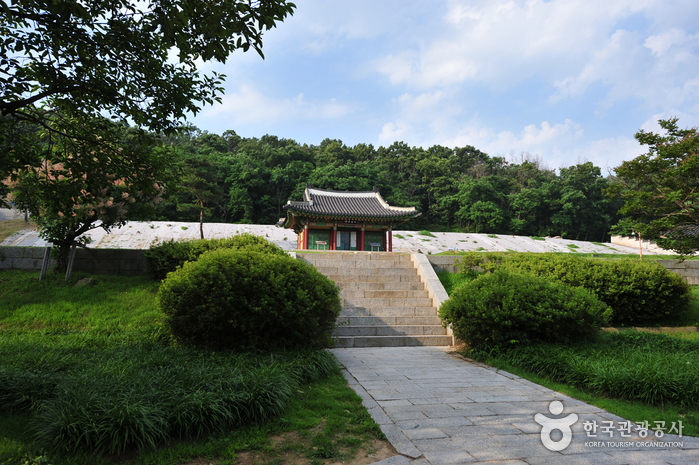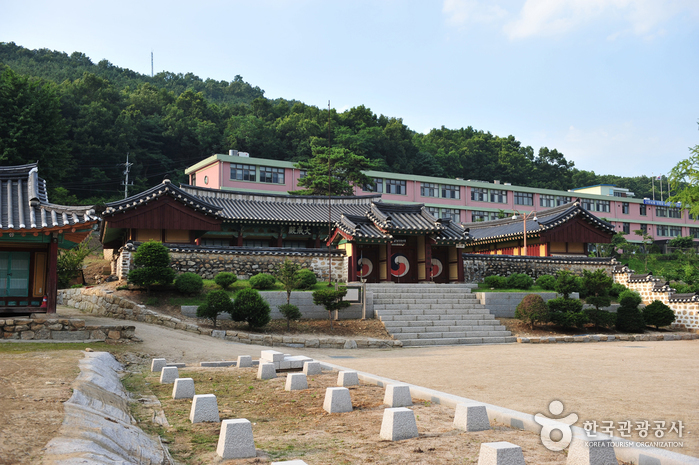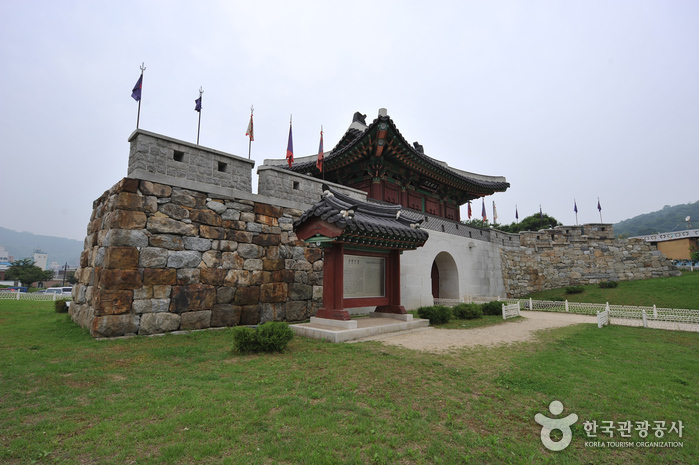Goryeogung Palace Site (고려궁지)
12.1 Km 32458 2021-06-01
394, Ganghwa-daero, Ganghwa-gun, Incheon
+82-32-930-7078
Goryeogung Palace Site on Ganghwado Island is the site of the royal palace where the people of the Goryeo dynasty (918-1392) resisted the Mongolian invasion for 39 years. In the 19th year of his reign, King Gojong moved the capital to Ganghwa on account of its natural and strategic advantages. During the Byeongjahoran (Chinese invasion of Korea) in 1637, the palace was lost by force to the Qing dynasty of China. Later, Joseon Dynasty palace building and Ganghwa Yusubu (Ganghwa governor’s office) buildings existed in the Goryeo palace site but were destroyed by the French army during the Byeonginyangyo (French Campaign against Korea). Nowadays, the only structures that remain are the Dongheon main office (built in 1638) and Ibangcheong administration office (built in 1654). The palace and its subsidiary buildings were restored in 1977. It has historical lessons of the spirit of independence and overcoming national crisis.
Soswaewon Ganjang Gejang Gimpo Main Branch (소쇄원간장게장 김포본점)
12.1 Km 25261 2024-02-20
53 Geumpo-ro 1915beon-gil, Haseong-myeon, Gimpo-si, Gyeonggi-do
031-983-8801
Soswaewon Ganjang Gejang Gimpo Main Branch is a restaurant specializing in ganjang gejang (soy sauce marinated crab), housed in a hanok-style building. Ganjang gejang is a Korean dish consisting of live crabs marinated in a seasoning made by boiling various vegetables with soy sauce. In addition to their signature ganjang gejang jeongsik, the sogalbijjim jeongsik (braised beef galbi set menu) is also popular. The set menu includes a main dish, doenjang jjigae (soybean paste jjigae), dolsotbap (hot stone pot rice), and side dishes.
Laveniche March Avenue (라베니체 마치에비뉴)
12.4 Km 1 2023-08-08
Janggi-dong, Gimpo-si, Gyeonggi-do
Laveniche March Avenue is a shopping avenue established along the artifical Golden Waterway in Gimpo, Gyeonggi-do. The area became a popular attraction after appearing in the popular drama series "Tale of the Nine Tailed (2020)" and several other television shows. The waterway sparkles in the sunlight during the day and glistens with the city lights at night, offering a romantic scenery anytime of the day.
Laveniche Plaza (라베니체광장)
12.4 Km 0 2023-02-02
810, Taejang-ro, Gimpo-si, Gyeonggi-do
Hangang Central Park, which was constructed as a result of the development of Gimpo Hangang New City, boasts a fabulous trail from the Golden Waterway by the waterside path all the way to Laveniche Shopping District. Golden Waterway Laveniche continues along a 2.68-kilometer-long trail and displays a variety of sceneries from the south to the north. Designed after Venice, the city of water, Laveniche features many different shops along the water that runs 1.7 kilometers for a round trip. Various living goods shops, restaurants, and pubs are set up on both sides of the water near the Central Plaza so it is a perfect place to spend time healing after a light stroll and shopping.
Lotte Mart - Gimpo Hangang Branch [Tax Refund Shop] (롯데마트 김포한강점)
12.4 Km 0 2024-04-16
41, Gimpohangang 2-ro, Gimpo-si, Gyeonggi-do
-
Lotte Himart - Gimpo Hangang Branch [Tax Refund Shop] (롯데하이마트 김포한강점)
12.4 Km 0 2024-04-22
41, Gimpohangang 2-ro, Gimpo-si, Gyeonggi-do
-
Yeongjong Grand Bridge (영종대교)
12.5 Km 19623 2022-07-26
Jangdo Island (Gyeongseo-dong, Seo-gu, Incheon-si) ~ Yeongjongdo Island (Unbuk-dong, Jung-gu, Incheon-si)
Yeongjongdaegyo Bridge connects the mainland of Incheon with Yeongjongdo Island that is home to the Incheon International Airport. Until the construction of this bridge, the only way to get to and from Yeongjongdo Island had been by boat. The 4.4 kilometer-long Yeongjong Bridge is the world’s first 3-dimensional self-anchored suspension bridge. The bridge carries both highways and rail lines on its decks, and 10,000-ton ships can pass under the bridge. The bridge was designed to withstand strong winds and earthquake.
It is the first bridge in Korea to have been completed through private capital inducement project. In addition to its function as a bridge, it is also an architectural beauty as the shape of the cable and the girder was designed to symbolize the eaves of the traditional Korean tile-roofed house. In 2002, Yeongjongdaegyo Bridge won the Tanaka Award by the Japan Society of Civil Engineers for the first time in Korea.
Olive Young - La Venice Branch [Tax Refund Shop] (올리브영 김포라베니체)
12.5 Km 0 2024-04-18
Store #212-214, Laveniche March Avenue 4-cha, 8, Gimpohangang 4-ro, Gimpo-si, Gyeonggi-do
-
Ganghwahyanggyo Confucian School (강화향교)
12.6 Km 22552 2020-06-29
58, Hyanggyo-gil, Ganghwa-gun, Incheon
+82-32-930-4571
First established in Ganghwa-eup during the 5th year of King Injong in the Goryeo dynasty (1127), Ganghwahyanggyo Confucian School was moved to Ganghwa-gun and then restored at the foot of Buksan Mountain (formally Songaksan Mountain) in 1624 by Sim Yeol during the 2nd year of King Injo.
Ganghwahyanggyo Confucian School is regarded as an important cultural and historical site in Ganghwa-eup.
Ganghwasanseong Fortress (강화산성)
12.7 Km 13509 2020-03-16
San 3, Gukhwa-ri, Ganghwa-gun, Incheon
+82-32-930-5464
Ganghwasanseong Fortress was originally earthen mountain walls, built during King Go Jong’s 19th year of reign (1232), after he moved to Ganghwado. It was built to repel attacks from the Mongols. The inner castle was destroyed when the capital was moved to another place, and at the beginning of the Joseon Era (1392-1910) the wall was again rebuilt with mud.
It went through much restoration until finally being rebuilt with stones. Ganghwasanseong Fortress originally had interior and exterior walls, but only the interior wall remains today. It has an approximate circumference of 1.2km. The exterior mud wall was approximately 9km in circumference with 8 gates. The huge exterior wall was built along the side of the east channel of Ganghwa, but no longer exists today. From 1977, the interior wall has been rebuilt many times over, but the east side of this wall has yet to be reconstructed.
There were four main gates in the wall. To the south, Anparu; to the east, Cheomhwaru; to the west, Manghanru; and to the north, Jinsongru. At the west gate, the historic Yeonmudang still remains. This area was where the soldiers used to train, and was also the place where the Korea-Japan Treaty of Peace and Amity (or Treaty of Ganghwa Island) was signed in 1876.
With its aching history
left behind and beautiful scenery, Ganghwasanseong Fortress serves as an ideal place for a brisk walk or refreshing drive.


![Lotte Himart - Gimpo Hangang Branch [Tax Refund Shop] (롯데하이마트 김포한강점)](http://tong.visitkorea.or.kr/cms/resource/23/2890523_image2_1.jpg)
![Olive Young - La Venice Branch [Tax Refund Shop] (올리브영 김포라베니체)](http://tong.visitkorea.or.kr/cms/resource/11/2880511_image2_1.jpg)


 English
English
 한국어
한국어 日本語
日本語 中文(简体)
中文(简体) Deutsch
Deutsch Français
Français Español
Español Русский
Русский